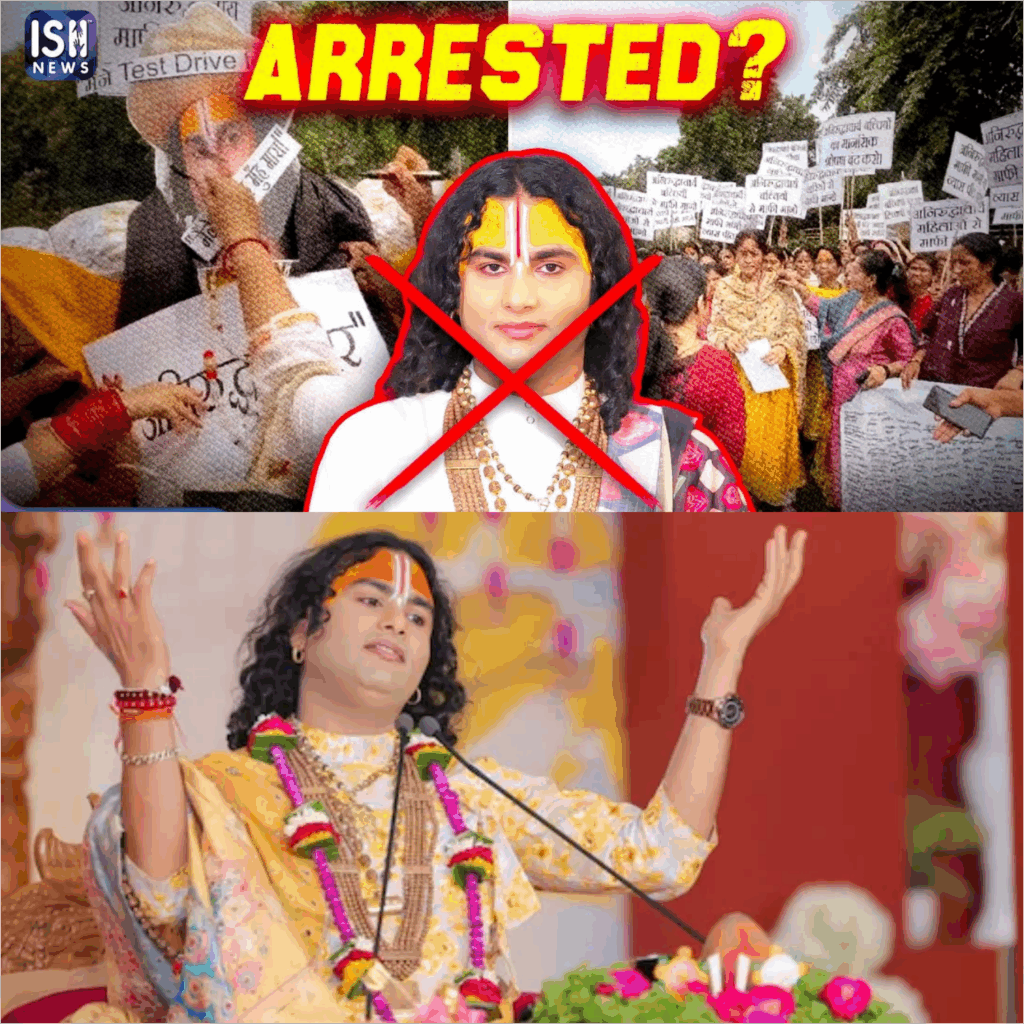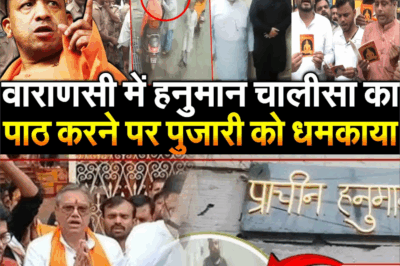Nationwide Outrage Against Aniruddhacharya: Protests Erupt Over Misogynistic Remarks
.
.
Nationwide Outrage Against Aniruddhacharya: Protests Erupt Over Misogynistic Remarks
India is witnessing a wave of anger and protests against Aniruddhacharya, a religious speaker whose recent comments about women have sparked national outrage. From effigies hit with slippers and photos burned in public squares to trending hashtags demanding his arrest, the controversy has ignited a debate about misogyny, free speech, and the role of religious leaders in modern society. Here’s a comprehensive look at the situation, the background of Aniruddhacharya, the nature of his remarks, and the response from citizens, celebrities, and activists across the country.

Who Is Aniruddhacharya?
Aniruddhacharya was born in 1989 in Jabalpur, Madhya Pradesh. He heads the Gauri Gopal Ashram in Vrindavan, Uttar Pradesh, and is known for his religious discourses that attract thousands of followers both in person and online. For years, he has built a reputation as a spiritual guide, offering what many saw as “smart guidance” on life, relationships, and morality. However, beneath the surface, his speeches have often contained controversial opinions, particularly regarding women and their roles in society.
The Spark: Insulting Comments About Women
The current storm of protests began after Aniruddhacharya made a series of deeply insulting comments about women in his recent public speeches. According to viral clips and eyewitness accounts, his remarks targeted unmarried women, women in live-in relationships, and even revered goddesses from Hindu mythology.
Some of his most shocking statements included:
-
Character Assassination of Unmarried Women:
He claimed that a 25-year-old unmarried woman is likely to have had “four different relationships,” using language that directly attacked their character and dignity.
Early Marriage Advocacy:
Aniruddhacharya suggested that girls should be married as early as 14 years old to “blend into the family” better—a statement widely condemned as regressive and dangerous.
Shaming Live-in Relationships:
He harshly criticized women who choose live-in relationships, implying moral inferiority and societal harm, while ignoring similar choices made by men.
Criticism of Clothing Choices:
He argued that women wearing “revealing clothes” attract unwanted male attention and should dress more conservatively to avoid sexual abuse or harassment—placing the blame squarely on women instead of perpetrators.
Disrespect Towards Goddesses:
Aniruddhacharya made remarks about Sita and Draupadi, two revered figures in Hindu mythology, that shocked listeners and were seen as deeply disrespectful.
Public Reaction: Protests and Viral Outrage
The backlash was immediate and intense. Across India, people took to the streets, burning his photos and effigies, some even hitting them with slippers—a traditional gesture of contempt. Social media erupted with hashtags demanding his arrest and severe punishment. Women’s rights activists, legal associations, and local commissions called for a formal inquiry, FIRs (First Information Reports) to be filed, and a proper trial.
The protests were not limited to ordinary citizens. Celebrities joined the chorus of condemnation. Disha Patani, a popular Bollywood actress, saw her sister Khushboo Patani publicly denounce Aniruddhacharya’s remarks, calling him “misogynistic” in a post that quickly went viral. Other public figures and organizations echoed similar sentiments, demanding accountability and respect for women.
The Pattern of Misogyny
This is not the first time Aniruddhacharya has made controversial statements targeting women. Over the years, his discourses have repeatedly included:
Criticism of unmarried women, labeling them as “problematic.”
Blaming women for incidents of sexual harassment based on their clothing.
Ignoring similar behaviors by men, thereby perpetuating gender stereotypes.
Making derogatory remarks about women in mythology and contemporary society.
Previously, many listeners ignored or dismissed these remarks. However, his recent speeches have intensified the focus on his misogynistic views, prompting a stronger and more organized response.
Legal and Social Demands
The demands from protesters and activists are clear:
FIRs and Legal Action:
Formal complaints and FIRs are being filed against Aniruddhacharya in various states. Activists are calling for a proper investigation and court proceedings to hold him accountable for hate speech and incitement.
Public Apology:
There is a widespread call for Aniruddhacharya to issue a sincere, respectful public apology to women—not just a cursory “sorry,” but an acknowledgment of the harm caused and a promise to change.
Accountability for Religious Leaders:
Many are questioning the unchecked power of religious speakers and the lack of consequences for spreading misogyny and regressive ideas under the guise of tradition.
The Debate: Free Speech vs. Hate Speech
The controversy has reignited a national debate about the limits of free speech. While Aniruddhacharya and his supporters argue that he has the right to express his views, critics point out that repeatedly derogating women, promoting harmful stereotypes, and inciting hatred do not fall under protected speech.
Legal experts note that India’s constitution guarantees freedom of expression, but also allows for restrictions when speech incites violence, hatred, or discrimination. Many believe that Aniruddhacharya’s remarks cross this line and warrant legal intervention.
Divided Public Opinion
Despite the widespread outrage, there remains a segment of society that supports Aniruddhacharya, citing his “deeply moving words” and traditional values. These opposing views reflect the broader cultural and generational divides in India regarding gender roles, marriage, and morality.
Supporters argue that his speeches reflect age-old traditions and that criticism is an attack on religious freedom. Opponents, however, insist that tradition cannot justify misogyny and that religious leaders must be held to higher standards of respect and inclusion.
The Role of Social Media
Social media has played a crucial role in amplifying the protests and spreading awareness. Videos of his speeches, clips of protests, and celebrity condemnations have gone viral, bringing the issue to national and even international attention. The rapid spread of information has empowered women and activists to organize, demand change, and hold public figures accountable.
The Way Forward
As the outrage continues, the focus is shifting from immediate protests to long-term change. Activists are calling for:
Greater oversight of religious discourses and public speeches.
Education and sensitization programs to challenge misogynistic beliefs.
Legal reforms to ensure swift action against hate speech and gender discrimination.
Many hope that the current wave of protests will serve as a turning point, prompting society to confront deep-rooted misogyny and demand greater respect for women in all spheres of life.
Conclusion
The nationwide outrage against Aniruddhacharya is more than a reaction to one man’s words—it is a reflection of India’s ongoing struggle with gender equality, free speech, and the role of tradition in modern life. As protests continue and legal action is pursued, the message from citizens, activists, and celebrities is clear: misogyny will no longer be tolerated, and those who perpetuate it must be held accountable.
Aniruddhacharya’s future remains uncertain, but the movement he has sparked is likely to have lasting effects. Whether he returns to apologize with deep respect or faces legal consequences, the protests have already made one thing clear—India’s women will not be silenced, and the demand for dignity and equality is stronger than ever.
Stay tuned for updates as this story develops.
.
News
Pregnant Katrina Kaif Facing Complications In Baby Delivery In Old Age Pregnancy
Pregnant Katrina Kaif Facing Complications In Baby Delivery In Old Age Pregnancy . . Katrina Kaif Faces Complications in Pregnancy…
Malaika Arora visits Arbaaz Khan and Sshura Khan as Blessed with by Girl at Hinduja Hospital!
Malaika Arora visits Arbaaz Khan and Sshura Khan as Blessed with by Girl at Hinduja Hospital! . . Malaika Arora…
Salman Khan got emotional for Arbaaz Khan Blessed with a Baby Girl with Shura Khan
Salman Khan got emotional for Arbaaz Khan Blessed with a Baby Girl with Shura Khan . . Salman Khan Gets…
Priest threatened for reciting Hanuman Chalisa in Varanasi Yogi police arrested Abdul Nasir and his son…
Priest threatened for reciting Hanuman Chalisa in Varanasi Yogi police arrested Abdul Nasir and his son… . . Priest Threatened…
Arbaaz Khan Blessed with a Girl with Shura Khan, Salman Khan met Daughter at hospital
Arbaaz Khan Blessed with a Girl with Shura Khan, Salman Khan met Daughter at hospital . . Arbaaz Khan and…
Pregnant Katrina Kaif is being looked after, the countdown to the baby’s arrival has begun, fans are excited!
Pregnant Katrina Kaif is being looked after, the countdown to the baby’s arrival has begun, fans are excited! . ….
End of content
No more pages to load










